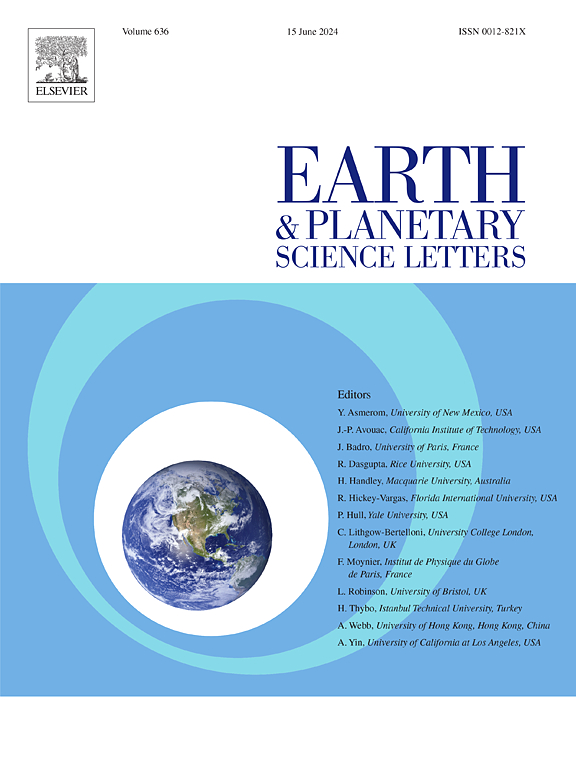含循环氮和原始氮的混合地幔柱:来自Reykjanes Ridge和Rochambeau Bank的受羽状影响的玄武岩玻璃的见解
IF 4.8
1区 地球科学
Q1 GEOCHEMISTRY & GEOPHYSICS
引用次数: 0
摘要
地幔源中氮(N)的来源在原始起源(即在地球形成期间获得)和与地表物质俯冲有关的再循环起源之间一直存在激烈的争论。尽管羽状岩浆的N同位素数据有限,但现有数据显示,羽状岩浆(δ15N >-2‰)与海中脊玄武岩地幔源(即DMM;δ15n = -5±2‰)。本文给出了两组特征明显的羽状影响的高3He/4He海底玄武岩玻璃的n同位素和稀有气体同位素数据:1)劳弧后盆地东北部的罗尚博滩(高达~ 23 RA,其中RA指的是大气3He/4He比),以及2)冰岛南部的雷克雅内斯脊(高达~ 18 RA)。这些样品组与不同的构造环境有关:汤加俯冲板块与劳弧后盆地下的萨摩亚羽流相互作用,而中大西洋海岭与雷克雅内斯海岭的冰岛羽流相互作用。对比鲜明的构造环境提供了一个独特的机会,可以破译地幔柱中N的来源,以及地幔柱与其他地幔成分(包括俯冲板块和DMM的回收物质)的相互作用。结果表明,罗尚博浅滩(δ15N在+1.3‰~ +2.8‰之间)和雷克雅内斯岭(δ15N在-2.3‰~ +0.1‰之间)样品的δ15N值相对于DMM均呈富集特征。Rochambeau Bank的数据与DMM的三元混合相一致(δ15N = -5±2‰;N2/3He = 3.7±1.2 × 106;N2/40Ar* = 138±65),是邻近汤加板块的俯冲组分,含再生氮(δ15N = ~ +3‰);N2/3He = ~ 109;N2/40Ar* = ~ 5 × 106)和δ15N = ~ 0‰,N2/3He = ~ 2 × 105和N2/40Ar* = ~ 40的第三个分量,我们将其归因于富含原始N的萨摩亚羽流成分。相比而言,Reykjanes Ridge资料与冰岛资料相结合,符合DMM,具有循环N的羽流成分(δ15N从0‰到+6‰;N2/3He = ~ 109;N2/40Ar* = ~ 5 × 106)和原始N (δ15N从-2‰到+2‰;N2/3He = ~ 2 × 105;冰岛深部地幔柱的N2/40Ar* = ~ 40)端元。这与冰岛地幔柱固有的循环氮和原始氮的存在是一致的。通过整合来自其他全球羽流影响样本(即社会,夏威夷和中印度脊)的N数据,我们表明全球数据集与DMM之间的三元混合一致,并且羽流成分同时携带回收N和原始N。因此,深羽流来源的氮可能是混合成分,既包含俯冲板块的回收N,也包含地球早期形成阶段保留的原始N。相对于对流的MORB地幔(~ -5‰),羽流地幔源内表观原始N组分的δ15N较重(-2‰至+2‰),可能需要从外太阳系向早期吸积地球添加富15n的碳质物质。本文章由计算机程序翻译,如有差异,请以英文原文为准。
Hybrid mantle plumes with recycled and primordial nitrogen: Insights from plume-influenced basaltic glasses from Reykjanes Ridge and Rochambeau Bank
Sources of nitrogen (N) in the plume mantle source remains hotly debated between a primordial origin (i.e., acquired during Earth’s formation) and a recycled origin associated with subduction of surficial material. Although N isotope data for plume-derived magmas are limited, the available data show clear differences in N isotope compositions between plume (δ15N >-2 ‰) and the depleted mid-ocean-ridge basalt mantle sources (i.e., DMM; δ15N = -5 ± 2 ‰). Here we present N-isotope and noble gas isotope data from two suites of well-characterized plume-influenced submarine basaltic glasses with high 3He/4He: 1) the Rochambeau Bank in the northeastern Lau backarc basin (up to ∼23 RA, where RA refers to the atmospheric 3He/4He ratio), and 2) the Reykjanes Ridge (up to ∼18 RA) south of Iceland. These sample suites are associated with different tectonic settings: the Tonga subducting slab interacts with the Samoan plume beneath the Lau backarc basin, whereas the Mid-Atlantic Ridge interacts with the Icelandic plume at the Reykjanes Ridge. The contrasting tectonic settings provide a unique opportunity to decipher both the origin of N in plume mantle sources and the interaction of the plume mantle with other mantle components, including recycled material from subducting slabs and the DMM. Our results show that Rochambeau Bank (δ15N from +1.3 ‰ to +2.8 ‰) and Reykjanes Ridge samples (δ15N from -2.3 ‰ to +0.1 ‰) are both characterized by δ15N values that are enriched relative to the DMM. Rochambeau Bank data are consistent with ternary mixing between the DMM (δ15N = -5 ± 2 ‰; N2/3He = 3.7 ± 1.2 × 106; N2/40Ar* = 138±65), a subduction component from the adjacent Tonga slab with recycled N (δ15N = ∼+3 ‰; N2/3He = ∼109; N2/40Ar* = ∼5 × 106), and a third component with δ15N = ∼0 ‰, N2/3He = ∼2 × 105 and N2/40Ar* = ∼40, which we attribute to the Samoan plume component enriched in primordial N. In contrast, Reykjanes Ridge data, combined with Iceland data, are consistent with ternary mixing among the DMM, plume components with recycled N (δ15N from 0 ‰ to +6 ‰; N2/3He = ∼109; N2/40Ar* = ∼5 × 106) and primordial N (δ15N from -2 ‰ to +2 ‰; N2/3He = ∼2 × 105; N2/40Ar* = ∼40) endmembers in deep Icelandic mantle plumes. This is consistent with the presence of both recycled and primordial N being intrinsic to the Icelandic mantle plume. By integrating N data from other global plume-influenced samples (i.e., Society, Hawaii, and Central Indian Ridge), we show that the global dataset is consistent with ternary mixing among the DMM, and plume components entrained with both recycled N and primordial N. Nitrogen in deep plume sources is therefore likely hybrid in composition, containing both recycled N from subducting slab and primordial N retained from Earth's early stages of formation. The heavier δ15N of an apparent primordial N component within plume mantle sources (-2 ‰ to +2 ‰) relative to that of the convecting MORB mantle (∼-5 ‰) potentially requires an addition of 15N-rich carbonaceous material from the outer solar system to the early accreting Earth.
求助全文
通过发布文献求助,成功后即可免费获取论文全文。
去求助
来源期刊

Earth and Planetary Science Letters
地学-地球化学与地球物理
CiteScore
10.30
自引率
5.70%
发文量
475
审稿时长
2.8 months
期刊介绍:
Earth and Planetary Science Letters (EPSL) is a leading journal for researchers across the entire Earth and planetary sciences community. It publishes concise, exciting, high-impact articles ("Letters") of broad interest. Its focus is on physical and chemical processes, the evolution and general properties of the Earth and planets - from their deep interiors to their atmospheres. EPSL also includes a Frontiers section, featuring invited high-profile synthesis articles by leading experts on timely topics to bring cutting-edge research to the wider community.
 求助内容:
求助内容: 应助结果提醒方式:
应助结果提醒方式:


